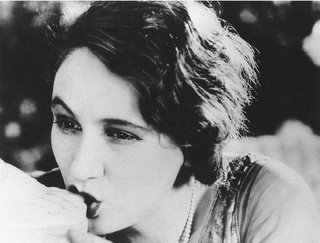48. L'Age D'Or (1930)

Directed by Luis Buñuel
Synopsis
Scorpions! Bishops! A kind of Resistance group! Dead Bishops! People on Boats! A Rape! An arrest! A big city! A Cow On A Bed! Stuff! A Party! Sucking on statuesque toes! Kissing the Maestro! Christ as a Perv! Finis.
Review
We had gotten Buñuel before in Chien Andalou and that was the superior film. This is not to say, however, that this is not a great film, which it is, but the surrealism is much more digestible in the 15 minutes of Chien Andalou than on the full hour of this film.
The themes are the same, sex and death, but L'Age D'Or diverges from Chien Andalou in the sense that it has a kind of loose plot, it is not completely disjointed and not as "crazy" as Chien. You still have to admire the dementia that led to the production of this flm. It is absolutely insane, the description of Imperial Rome is particularly amusing for example, such as the fact that sometimes on Sundays buildings crumble.
L'Age D'Or still manages to shock, there is the execution of a child, Ralph Fiennes in Schindler's List style, there is the veiled references to female masturbation (or was it just me who noticed the hand in the advert perilously close to a mass of hair, or the position of the woman on the chaise longue, or the fact that that woman later has a bandaged finger and mentions she has felt sore all week?) as well as the allusion to fellatio, when Lya Lys finds herself alone in the garden, without her sexual partner she sucks the toe of a statue in a very suggestive way. I can only imagine what this was like for the audiences in 1930.
Buy it at Amazon UK
Final Grade
7/10
Trivia
From Wikipedia:
L'Âge d'Or (The Golden Age) is a 1930 surrealist film directed by Luis Buñuel and written by Buñuel and Salvador Dalí.
The film was financed to the tune of a million francs by the nobleman Vicomte de Noailles, who commissioned a film every year for the birthday of his wife Marie-Laure de Noailles. When it was first released, there was a storm of protest. The film premiered at Studio 28 in Paris on 28 October 1930 after receiving its permit from the Board of Censors. In order to get the permit, Buñuel had to present the film to the Board as the dream of a madman. On 3 December 1930, a group of incensed members of the League of Patriots threw ink at the screen, assaulted members of the audience, and destroyed art work by Dalí, Joan Miró, Man Ray, Yves Tanguy and others on display in the lobby. It was subsequently banned for nearly 50 years, and did not have its official US premiere until 1-15 November 1979 at the Roxie Cinema in San Francisco.
In the final vignette, the placecard narration tells of an orgy of 120 days of depraved acts and tells us that the survivors of the orgy are ready to emerge. From the door of a castle emerges a Christ-like figure. This scene is alluded to in the opening sequence, which resembles a short science film about a scorpion. The narrator tells us that the Scorpion has five parts, but the sting is in the tail. Pauline Kael described L'Âge d'Or as "Surreal, dreamlike, and deliberately, pornographically blasphemous."

2 Comments:
At 5:23 AM, Anonymous said…
Anonymous said…
Niice! I just finished my surrealism website... and the surrealist video section is http://www.surrealism-artlinks.com/Artist/Luis-Bunuel/FIlm-video-movie/ ...here. Mostly stuff by Luis Bunuel. About 1/2 of the folders have youtube/google videos.
At 1:20 PM, Francisco Silva said…
Francisco Silva said…
Thanks Josh, that's quite useful.
Thanks for reading!
Post a Comment
<< Home